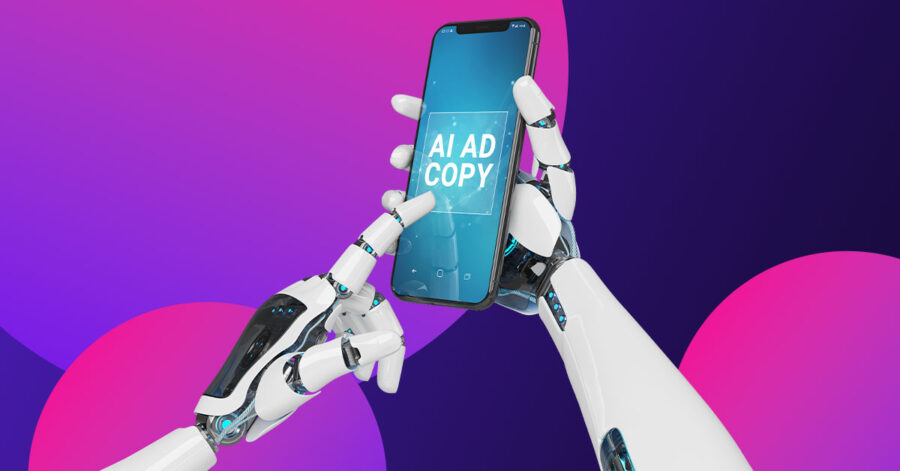
In today’s fiercely competitive marketing landscape, good ad copy is worth a lot. But writing it can be laborious and time-consuming. Enter AI technology: a practical tool that can save you time and energy generating ad copy that resonates with your target audience. Here’s how you can use AI for ad copy and get positive results.
Table of Contents
- Understanding AI in Advertising
- Advantages of Using AI for Ad Copy
- How to Use AI in Ad Copy Creation
- Best Practices for AI-Generated Ad Copy
Understanding AI in Advertising
Advertising has been around for centuries, you wouldn’t think it would need the help of Artificial Intelligence. But it does. Even the most experienced copywriter will occasionally struggle with mental block, work overload, and lack of creativity, especially during crunch times. AI is proven a powerful tool in speeding the ad copywriting process and has many other benefits.
Firstly, traditional ways will tell you that you need to allot hours of research to analyze mountains of data to understand who you’re writing for. You will also need a deep pool of talent to write persuasive headlines and other advertising copy. On the other hand, AI can simultaneously do these for you and more in a fraction of the time.
It allows you quick access to knowledge about the following:
- Audience insights: AI analyzes buyer history, social media chatter, and other data to help you gain their preferences, pain points, and their subconscious desires.
- Compelling headlines: AI algorithms will scan high-performing ads and learn about them. This leads it to generate attention-grabbing headlines that resonate well with your audience.
- Ad copy variations: AI will suggest variations in your ad copy based on data gathered about the best practices and proven formulas.
- Customer’s sentiment: AI can understand how your target market perceives your brand and its competition. This lets you review and refine your messaging to create the most impact.
Lastly, AI offers a spectrum of tools for ad copywriting that will fit your specific needs, such as the following:
- Copywriting tools: Jasper of Copy.ai can serve as your copywriting assistant that will generate ad copy while giving you feedback on your own writing.
- Keyword research tools: SEMRush or Ahrefs are AI-powered platforms that help you identify relevant keywords and provide you with an in-depth analysis of their search volume and competition.
- Sentiment analysis tools: Sprout Social or Brand24 can help you analyze the emotional tone of your brand in online conversations to give you insights to help you improve your ad copy.
While AI can do all of the above, do note that human intervention is still crucial. The technology does a fantastic job of analyzing data and providing creative suggestions, but it cannot do the following:
- Understand context: AI cannot understand the concept of language nuances, humor, or cultural references. If you want to include these in your advertising campaigns, you need to inject context yourself.
- Maintain your brand voice: The technology won’t be able to grasp your brand’s unique personality and tone. You must guide it to ensure it generates copy that aligns with your brand identity.
- Fact check: AI can generate ad copy but may not always provide you with factually correct data. It can’t edit for you, which means you still need a human editor to review, refine, and check your copy’s accuracy.
Advantages of Using AI for Ad Copy
For many advertising agencies, AI is changing the way they write ad copy. No more long hours brainstorming or creating drafts after drafts of copy that offer no guarantee of its effectiveness. The following are but a few of the many advantages of using AI for ad copy:
- Enhancing your creativity: AI can generate creative ideas, killer headlines, copy variations, or perspectives you may not have thought of before. It can dispel writer’s block while also pushing your creative boundaries.
- Improving your targeting capabilities: AI can analyze vast amounts of data in seconds. In a shorter time, you’ll get to discover deep audience insights, preferences, and pain points. This allows for targeted copy that resonates with your audience’s needs and desires.
- Better customized content creation: AI can generate ad copy for various audience segments to help you increase relevance and engagement.
- Data-driven optimization: AI analyzes your ad’s performance to identify areas that need improving so you can refine and optimize your campaigns accordingly.
- Automates repetitive tasks: Keyword research and writing copy variations become easy with the use of AI for ad copy. It increases your team’s efficiency, allowing more time for strategic thinking and campaign management.
- Reducing costs: AI can reduce your copywriting costs by streamlining workflows and lessening the need for other copywriting resources.
- Available 24/7: AI is available for use 24/7, you won’t have to wait for your human writers to time in to write copy. You can give in to inspiration strikes any time of the day.
- A/B testing: There are AI tools that can conduct A/B testing on your ad copy. This allows you to identify the most suitable and effective messaging for your audience.
- Enhanced scalability: AI can instantly generate ad variations that significantly help scale your campaigns.
- Ensuring compliance and accuracy: AI can help you ensure that your ad copy adheres to industry standards and regulations, which can reduce potential risks.
How to Use AI in Ad Copy Creation
Here is a guide to help you use AI to write your ad copy:
- Define clear campaign goals and target audience: Think about what you want your ads to achieve. Do you want more conversions? Awareness for your brand or more website visits? Also, define who the ad copy is for. List demographics, online behavior, pain points, preferences, and interests.
- Choose your AI ad copywriting tool: There is an AI tool for every budget and purpose. You can use ChatGPT and Rytr for your copywriting duties, Moz and Ahrefs for keyword research, and Buzzsumo or Sprout Social for sentiment analysis.
- Get data and provide context: Depending on your chosen AI tool, feed it relevant data such as information about your target audience, your competition, and brand guidelines. Write prompts that clearly communicate your brand’s voice, tone, and messages.
- Generate ad copy: Use your AI tool to suggest headlines, copy variations, and CTAs. Review for accuracy, factuality, and if they align with your brand’s mission and vision.
- Analyze and optimize: Use AI analytics to track and monitor your ads’ performance and find areas that need improvement. Continuously refine your ad copy based on audience feedback.
A few tricks to help you along:
- Take baby steps: Avoid overwhelming yourself by replacing your copywriting tasks with an AI tool. Start small with specific tasks such as writing headlines or searching for keywords.
- Think of AI as a tool: AI is not meant to replace human copywriting; rather, think of it as a tool to help you. Generate suggestions and ideas and use them to refine your writing.
- Be mindful of biases: AI outputs have no guarantee that they adhere to ethical and legal standards. Make sure to fact-check when possible.
Best Practices for AI-Generated Ad Copy
There are no hard and fast rules for using AI for ad copy. However, there are a few best practices you can follow to make the most out of this powerful technology:
Before starting, consider doing the following:
- Set clear and definite goals: Know what you want your ads to achieve, how you will do it, and who they are for. These will be your guide in the entirety of your campaign.
- Choose the right AI tool: AI tools vary in features, capabilities, and price. Find one that fits your requirements and budget, preferably one that integrates smoothly with your existing workflow.
When crafting your ad copy, take note of the following:
- Write descriptive prompts: The more descriptive prompts you give to the AI tool, the better it can understand your needs. In effect, you are teaching it to generate content exactly how you want it. Specify your brand voice, tone, and key messages.
- Always start with a brainstorming session: Use the AI tool to generate headlines, copy, and CTAs. In the case of writer’s block, this is the best way to overcome it while discovering new ideas.
- Edit and refine relentlessly: Bear in mind that AI is not foolproof, and you need to review and refine continuously. Check for accuracy, factuality, and alignment with your brand.
- Inject humanity into your ad copy: It takes a human to write ad copy that sounds like a human. While AI can practically do magic, it’s not the end-all and be-all of ad copywriting. It cannot capture the true essence and emotional nuances of storytelling. Ensure you focus on human-centric stories to create ad copy that truly resonates.
For optimization and iteration, consider the following:
- Use A/B testing: Even if you use AI for your copywriting tasks, you still need A/B testing to see how your campaigns perform. This will help you craft content that resonates and targets your exact audience.
- Analyze data: Get insights on your ad performance using AI analytics data to identify areas needing refining.
- Check for compliance: Ensure your ad copy complies with industry standards and regulations.
Final Thoughts
Embracing AI technology in crafting ad copy offers marketers a powerful ally in their quest for effectiveness and impact. By collaborating with AI, marketers can tap into its immense potential to analyze data, identify trends, and generate compelling content that resonates with target audiences. This partnership between human creativity and AI-driven insights not only streamlines the process but also elevates the quality and relevance of ad copy.
Penji strives to be at the forefront of this collaboration helping modern brands harness AI for marketing and design. Explore our services and see how we can help you get the most out of AI.
About the author

Celeste Zosimo
Celeste is a former traditional animator and now an SEO content writer specializing in graphic design and marketing topics. When she's not writing or ranking her articles, she's being bossed around by her cat and two dogs.










